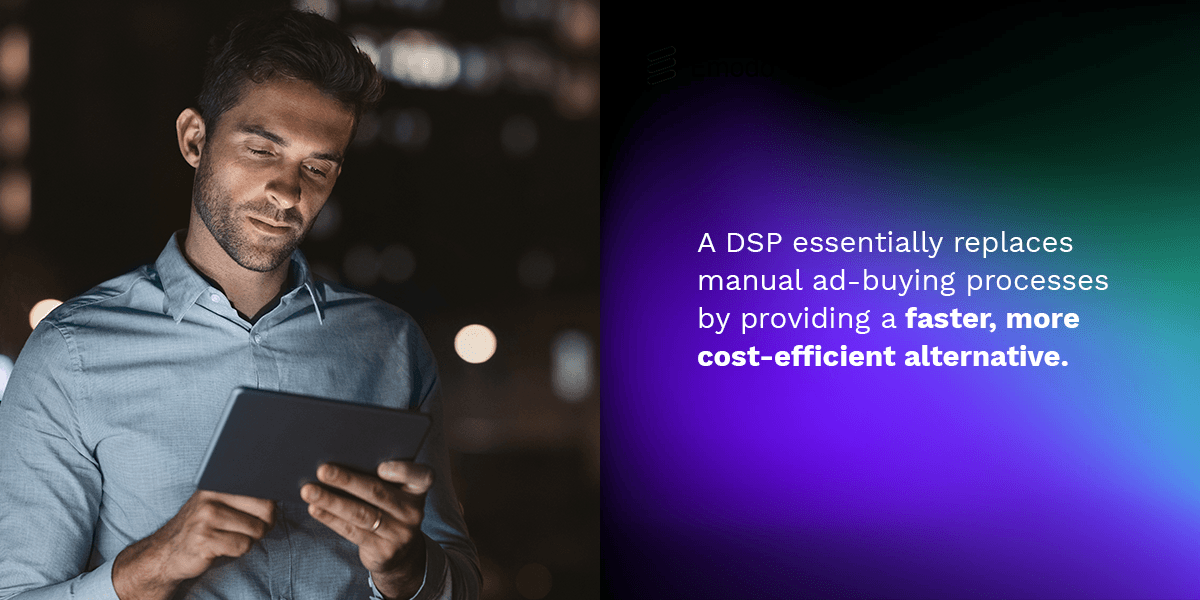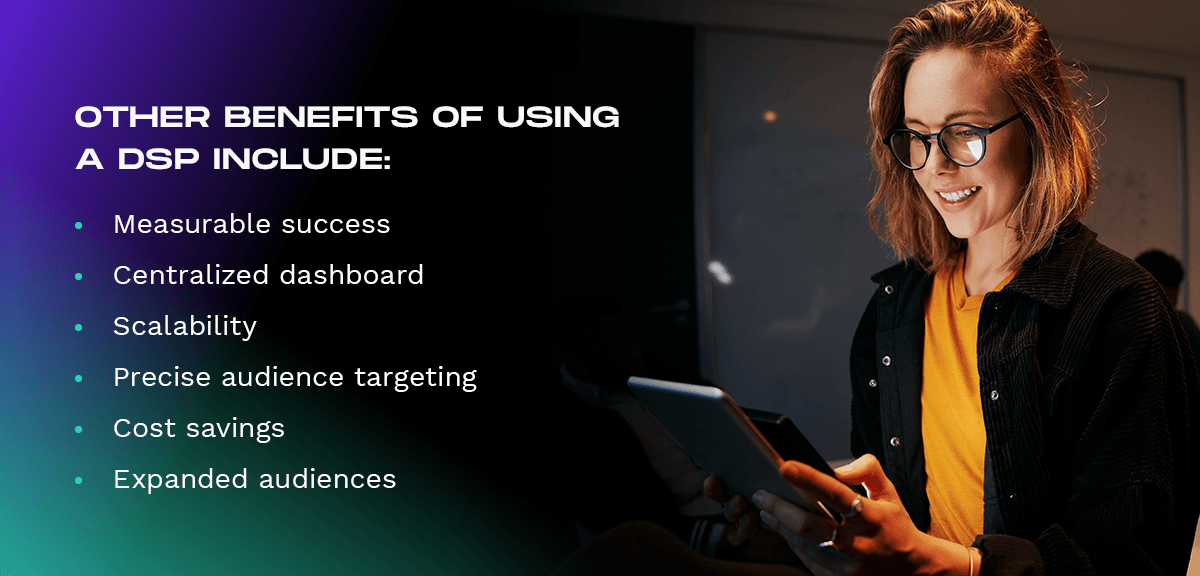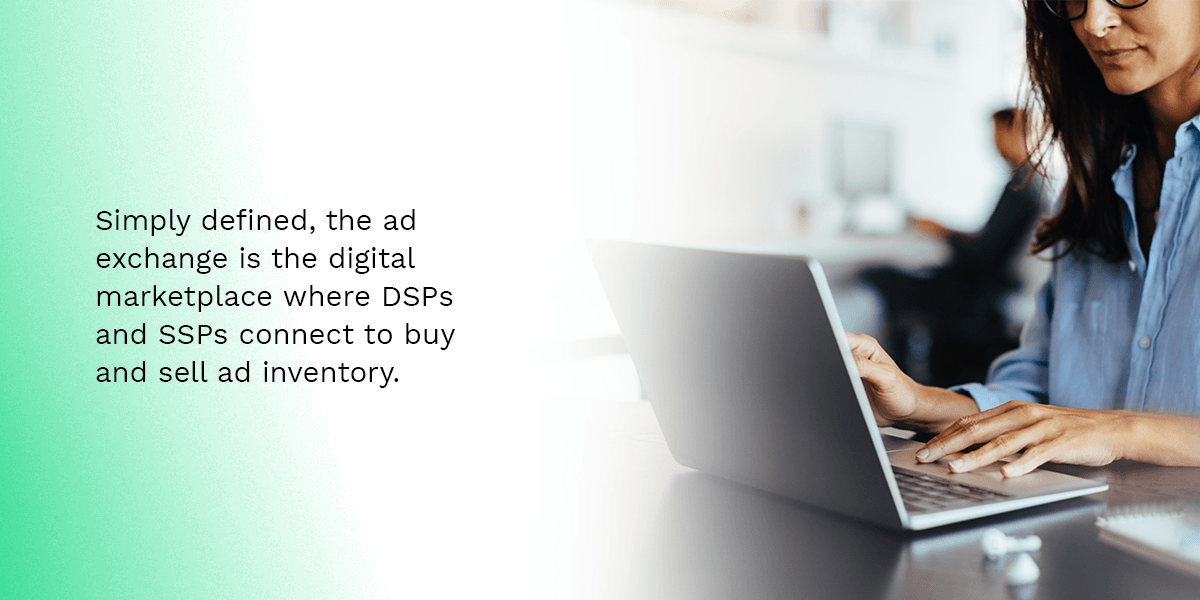According to research from eMarketer, programmatic digital display ad spending is projected to increase by 15.2% in 2023, even though third-party and device IDs are on their way out. Many are hailing programmatic solutions like demand-side platforms (DSPs) as the future of digital advertising.
So, what is a DSP, and what makes it worth your investment? We’ll discuss these questions and more in this guide.
What is a demand-side platform?
A demand-side platform is a programmatic advertising platform that has two primary functions:
- Streamlining campaign management by consolidating all your campaigns under one platform.
- Automating the ad bidding process by connecting buyers and suppliers to various ad exchanges.
Many DSPs source inventory from multiple ad exchanges, which removes traditional constraints like geographical location, expanding options for both publishers and advertisers. In this way, a DSP essentially replaces manual ad-buying processes by providing a faster, more cost-efficient alternative.

Additionally, by presenting all ad campaigns in one convenient hub, a DSP enables advertisers to run and manage multiple campaigns simultaneously with minimal friction. This capability enables companies to advertise at scale more effectively than previous methods allowed.
What are the parts of a demand-side platform?
A typical DSP comprises several functions for creating and managing campaigns. Today’s top DSPs include the following components:
- Bidder: As the most important part of the DSP, the bidder is what places bids on ad impressions. To minimize latency during bidding, most DSPs will leverage multiple data centers in various locations.
- Ad server: The ad server is what serves ad elements to the publisher’s website. A DSP might use its own internal ad server, or it might integrate with an external one. This component may also include fraud prevention capabilities to eliminate false ad inventory.
- User profiling: When users view an ad from a DSP, the DSP records their data and uses it to build user profiles for remarketing and ad optimization.
- Campaign tracker: This component enables advertisers to track and analyze data about their ad effectiveness. Common metrics include ad impressions, viewability, clickthrough rate and conversions, among others.
- Budget manager: Also known as the cashier or the banker, the budget manager allows advertisers to set the budget rules for each campaign.
- Integrations: A DSP must integrate with supply-side platforms (SSPs) and ad exchanges to buy advertising space. It may also integrate with other third-party tools to expand its functionality, such as analytics and data management platforms.
Some DSPs offer additional capabilities and services, such as those included in a managed-service DSP. Comparing each platform is an important step in deciding which is the best fit for your advertising strategy.
Why are demand-side platforms important?
Traditionally, buying and selling ad space was a slow, manual process that involved extensive negotiations between publishers and advertisers. Those who have been in the industry for many years may remember the frustration of sending emails and spreadsheets back and forth for days before finally striking a deal.
That inefficiency is exactly why DSPs are so necessary today. With the rapid expansion of the internet, we need a solution that cuts costs and saves time.
With a DSP, advertisers can create campaigns and purchase ad space easily, freeing themselves up to focus on developing great creative. It also benefits user acquisition experts by allowing them to prioritize other important tasks, such as user base segmentation and campaign assessment.
Additionally, DSPs automate time-consuming and repetitive processes in setting up and managing campaigns. You can see how well — or how poorly — your campaigns are performing right from the dashboard. With this information readily accessible, you have the agility to maximize your ad campaigns in real time.
For example, if you notice one of your campaigns is doing significantly worse than expected, you can pull the ads quickly and avoid unnecessary risk. Similarly, if you find one campaign is outperforming all the others, you can reallocate funds and invest more into it all from one centralized dashboard.
Why do you need a DSP?
DSPs improve your chances of long-term campaign success by streamlining programmatic advertising and campaign management. They also eliminate the frustrations of having to deal with multiple advertising platforms.

Other benefits of using a DSP include:
- Measurable success: DSPs enable you to measure each campaign’s results, which you can use to improve future campaigns and drive higher return on investment (ROI).
- Centralized dashboard: Advertisers can track and manage multiple campaigns across different platforms and networks all from their DSP dashboard. Each platform usually includes tools for managing, optimizing and tracking your campaigns, so you can gain valuable insights into how your ads are performing in real time.
- Scalability: A DSP allows you to buy high-quality ad space at scale with minimal additional effort. This capability will be increasingly vital for mobile advertisers moving forward.
- Precise audience targeting: The DSP’s user profiling functionality enables you to reach more specific audience segments, reducing the need for data from sources like third-party cookies.
- Cost savings: A DSP enables you to automatically filter out publishers that are too costly for your budget so you can get the most cost-effective ad space possible. DSPs also save time by automating the real-time bidding process, so you can maximize your profitability and productivity in other areas.
- Expanded audiences: DSPs and SSPs provide new opportunities for advertising by eliminating traditional barriers to certain audiences. With a DSP, you can take advantage of ad space worldwide if you like.
Like any technological solution, using a DSP comes with some challenges. For example, some DSPs lack features like ad fraud detection, which means the program can purchase fake impressions without your knowledge. Understanding what’s included in each DSP is important for choosing the right platform and bringing in a better ROI.
How does a demand-side platform work?
Rather than spending countless hours manually bidding on ad space, you can buy digital inventory with minimal effort using a DSP.
That’s because the whole process — aside from the initial setup — is automated from start to finish. It breaks down like this:
- Setup: First, you upload your ad creative and select your target audience. You also establish a budget for your campaigns.
- Search: Publishers use ad exchanges and SSPs to make ad inventories available on the DSP. The DSP searches through its publisher network to find mobile apps and websites that fit your input criteria.
- Bid: The DSP decides whether to bid on a publisher’s impression based on how well it meets your criteria. If it chooses to bid, the real-time bidding process begins and ends in milliseconds.
- Purchase: If your DSP wins the bid, it purchases the impression. The publisher then displays your ad on their website or app.
This process enables advertisers to design top-to-bottom campaigns that can target audiences at every step of the sales funnel, driving higher conversions and more memorable impressions.
Demand-side platform vs. supply-side platform
A DSP uses ad exchanges to help advertisers buy digital inventory from publishers for the lowest possible price point. In comparison, an SSP is a platform that uses ad exchanges to help publishers sell their inventory while maximizing yield. SSPs give publishers more control over their inventory by enabling them to set rules for advertisers, including which types of ads they wish to accept, and set minimum rates for impressions.
This control helps publishers ensure they only accept ads that make sense for their brand image. For example, a kids’ TV network wouldn’t want to sell ad space to an accounting firm, and vice versa. Using filters, the network can ensure they sell to kid-friendly advertisers, such as ice cream companies or toy brands, to get the most out of their investment and preserve brand safety.
The two platforms need to interact for this relationship to work. DSP integration with SSPs is necessary for enabling advertisers to bid on digital inventory. This integration also enables publishers to make their inventory available to DSPs and advertisers on ad exchanges.
Essentially, the difference breaks down to the purpose of each platform. A DSP enables advertisers to purchase ad space, while an SSP enables publishers to sell ad space.
Demand-side platform vs. ad exchange
Simply defined, the ad exchange is the digital marketplace where DSPs and SSPs connect to buy and sell ad inventory. It’s a more technologically advanced version of the traditional ad network.

Ad exchanges use automated systems to serve everyone involved in digital inventory trading, from individual advertisers to full-service DSPs. Many DSPs source digital inventory from multiple ad exchanges to expand their geographical reach. Similarly, many SSPs connect to different ad exchanges to make their inventory available to as many potential buyers as possible.
Transparency is another major difference between DSPs and ad exchanges. A DSP gives advertisers the freedom to choose which sites they want to purchase inventory from, whereas an ad exchange simply lets advertisers view inventory their programmatic tech bids on. However, most ad exchanges still provide a significant amount of control by enabling advertisers to blacklist ad space and inventory that doesn’t suit their brands.
What are the types of demand-side platforms?
There are two main types of DSPs — self-serve and managed-service. Each one has its advantages and disadvantages. Ultimately, the DSP that’s best for your organization depends on your company size, budget and campaign goals.
Self-serve DSP
A self-serve DSP is a platform advertisers can use to purchase ad space and monitor campaigns without outside help. The benefits of using a self-serve DSP include:
- Total control: With no third parties to deal with, you maintain complete control over all your ad campaigns and intellectual property.
- Greater flexibility: Because you have control over your campaign, creative flexibility is all yours.
- Expanded server options: A self-service DSP expands your reach beyond the DSP’s existing network, enabling you to determine for yourself how and where you want to serve your creative.
The main drawback to a self-serve DSP is you’ll need an in-house team to manage your campaigns full-time through the platform. Additionally, because you’re managing it all yourself, you’ll experience a much steeper learning curve with a self-serve platform than with a managed-service DSP.
As a result, advertising agencies and larger organizations with dedicated advertising teams are more likely to benefit from self-serve DSPs than smaller organizations that outsource their advertising.
Managed-service DSP
A managed-service or “full-service DSP” acts more like a complete advertising agency than a software platform in that the organization that owns the platform also runs your campaigns for you.
Once you upload your creative, the DSP’s team takes over to manage and operate your campaign. While you maintain control over your creatives, branding and overall strategy, the DSP plans and runs your campaigns on a day-to-day basis.
While this arrangement offers less flexibility and transparency than a self-serve option, it can drive greater results for certain organizations. Some of the main benefits of using a managed-service DSP include:
- Expanded services: The managed-service DSP has access to extensive technological and human resources, so they can provide additional services through the account manager.
- Reliable expertise: With extensive experience in using their resources to optimize clients’ campaigns, managed-service DSPs can reference their models and algorithms to ensure campaigns run according to plan.
- Convenience: When you work with a managed services DSP, you don’t have to find a services provider or run services yourself. This makes it a potential game-changer for smaller companies, especially if they’re only beginning their advertising journey.
If you’re looking into working with a managed-service DSP, it’s important to compare each option to make sure you’re getting the best deal. Note which features each platform offers and how the platform fits into your budget. Spend time speaking with representatives from each company to get a more complete understanding of how their offerings work.
Working with Emodo Activate DSP
At Emodo, we understand that each campaign requires a different approach. Using a top DSP can help you manage all your campaigns through one centralized interface, so you can run and optimize campaigns in a way that works best for you and your brand.
Emodo Activate is a DSP that empowers advertisers to build more meaningful connections through differentiated advertising solutions such as Emodo Audiences and Emodo Adapt. This integration eliminates the high technology fees common among other leading DSPs, enabling you to do more with less.
Through Emodo Activate, you can create, manage and optimize campaigns across all your channels, including display and native ads. It also provides direct access to Emodo Exchange, enabling you to engage your audiences where they are through quality placements.
Maximize your opportunities with Emodo
Emodo Activate is one of the top demand-side platforms for advertisers looking to make a deeper impression. Our intelligent exchange puts your creative first, so you can serve your audiences rich, exciting advertising experiences they’ll remember.
With access to the latest artificial intelligence, consumer research and augmented reality tech, you’ll have everything you need to effectively reach those audiences. Plus, we provide our clients with multiple options, including white-glove managed services and a self-serve interface.
However you prefer to purchase inventory, Emodo can support you. Contact us today to learn more about how working with Emodo can help you maximize your digital advertising opportunities.
MORE LIKE THIS



